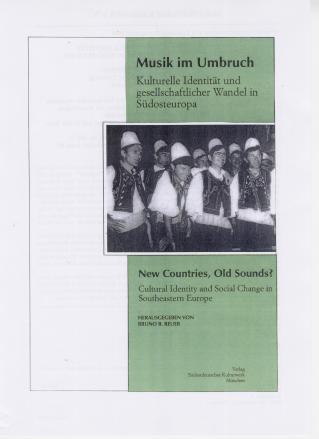 |
New Countries - Old Songs? - These were among the questions on the agenda of the symposium "Perspectives in Ethnomusicology - Techniques of Documentation and Intercultural Relations," which took place in 1990 in Budapest. Hrsg. von Bruno B. Reuer in Zusammenarbeit mit Lujza
Tari und Krista Zach |
Writing about the music of the war-torn region of southeastern
Europe, the authors ask the questions: What role does music play in the upheaval?
As new states formed out of the break-up of former Yugoslavia, have new cultures
formes as well? Have people found new culture and new identity within their
new states? Should music be praised as a unifying or a dividing force? Until
now, music was thought of as a force that brings everything together, one
that overcomes borders that have formed through language, customs, ideology
and nationalism. Instead of these divisions, music offers a unique perception
of reciprocal diversity. What is the importance of music, now and in the past,
for the people of southeastern Europe and elsewhere? How has music developed
after the fall of the "Iron Curtain"?
These were among the questions on the agenda of the symposium "Perspectives
in Musical Ethnology - Techniques of Documentation and Intercultural Relations,"
which took place in 1990 in Budapest. The discussion that took place in Budapest
was continued during another symposium in Berlin, which was attended by an
extended circle of participants. At the forefront of discussions were questions
regarding individual and the group identities as fostered by music. Does music
have a unifying or a dividing function? 29 participants spoke about music
and the musical background of the respective social context, and critiqued
forms and traditions. Another topic was the relationship between "old
and new" neighbors, a topic which gave clear indications of future tendencies.
With articles by:
Istvan Almási, Sofija Bajrektarevic, Marin Marian Balasa, Donna A.
Buchanan, Philip V. Bohlman, Nikos Dionysopoulos, Maria Domokos, Nice Fracile,
Erzsébet Hajdú, Ursula Hemetek, Jana Karastojanova, Natalie
Köhn, Katalin Kovalcsik, Katalin Lázár, Franz Metz, János
Pap, Katerina Pavlakis, Svanibor Pettan, Bruno B. Reuer, Timothy Rice, Pál
Richter, Klaus Roth, Maria Samokovlieva, Sergey Shyp, Roberto Starec, Jane
C. Sugarman, Lujza Tari, Nancy Thym-Hochrein, Jadranka Važanová-Horáková,
Susanne Ziegler